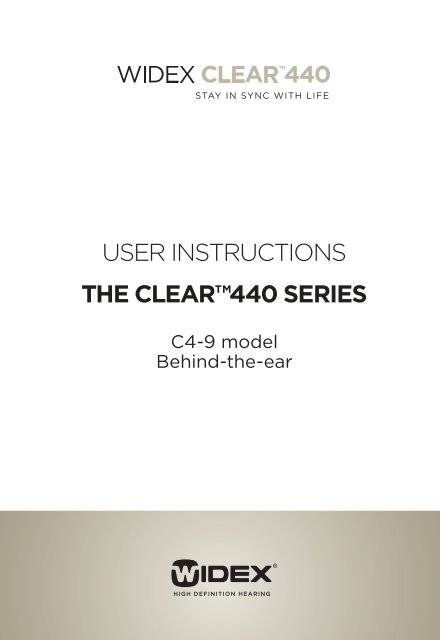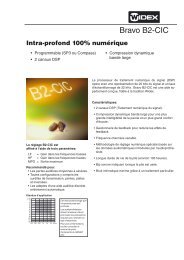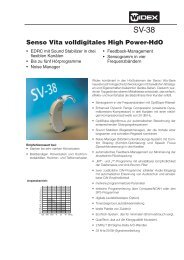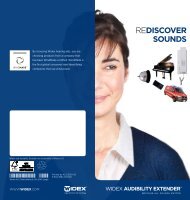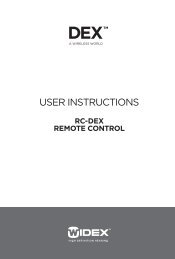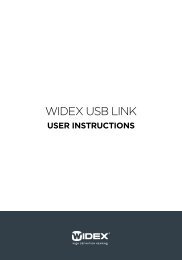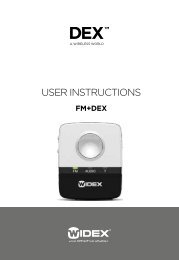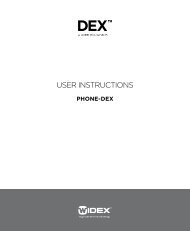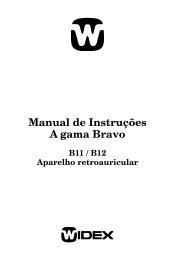Users instructions C4-9 - Widex for professionals
Users instructions C4-9 - Widex for professionals
Users instructions C4-9 - Widex for professionals
You also want an ePaper? Increase the reach of your titles
YUMPU automatically turns print PDFs into web optimized ePapers that Google loves.
USER INSTRUCTIONSTHE CLEAR440 SERIES<strong>C4</strong>-9 modelBehind-the-ear
YOUR WIDEX CLEAR440HEARING AID(To be filled out by the hearing care professional)Date: ______________________________________Battery size: ________________________________2
CONTENTSSYMBOLS. . . . . . . . . . . . . . . . . . . . . . . . . . . . . . . . . . . . . . . . . . . . . . 4THE HEARING AID . . . . . . . . . . . . . . . . . . . . . . . . . . . . . . . . . . . . . . 5Right/left identification. . . . . . . . . . . . . . . . . . . . . . . . . . . . . . . . . . 9Acoustic indicators . . . . . . . . . . . . . . . . . . . . . . . . . . . . . . . . . . . . . . 9The battery. . . . . . . . . . . . . . . . . . . . . . . . . . . . . . . . . . . . . . . . . . . . 10Inserting the battery . . . . . . . . . . . . . . . . . . . . . . . . . . . . . . . . . 10Low battery indication. . . . . . . . . . . . . . . . . . . . . . . . . . . . . . . . 12Turning the hearing aid on and off . . . . . . . . . . . . . . . . . . . . . . . 13Positioning the hearing aid . . . . . . . . . . . . . . . . . . . . . . . . . . . . . . 14Removing the hearing aid . . . . . . . . . . . . . . . . . . . . . . . . . . . . . . 15Volume adjustment . . . . . . . . . . . . . . . . . . . . . . . . . . . . . . . . . . . . 16Lost partner alarm . . . . . . . . . . . . . . . . . . . . . . . . . . . . . . . . . . . . . 18Listening programs. . . . . . . . . . . . . . . . . . . . . . . . . . . . . . . . . . . . . 19Switching between the listening programs . . . . . . . . . . . . . . 22Zen+ . . . . . . . . . . . . . . . . . . . . . . . . . . . . . . . . . . . . . . . . . . . . . . . 23Phone+ . . . . . . . . . . . . . . . . . . . . . . . . . . . . . . . . . . . . . . . . . . . . . 23Using a telephone. . . . . . . . . . . . . . . . . . . . . . . . . . . . . . . . . . . . . . 24CLEANING. . . . . . . . . . . . . . . . . . . . . . . . . . . . . . . . . . . . . . . . . . . . 25The hearing aid . . . . . . . . . . . . . . . . . . . . . . . . . . . . . . . . . . . . . . . . 26ACCESSORIES. . . . . . . . . . . . . . . . . . . . . . . . . . . . . . . . . . . . . . . . . 27IN CASE OF MALFUNCTION . . . . . . . . . . . . . . . . . . . . . . . . . . . . . 30CARING FOR YOUR HEARING AID. . . . . . . . . . . . . . . . . . . . . . . . 32WARNINGS . . . . . . . . . . . . . . . . . . . . . . . . . . . . . . . . . . . . . . . . . . . 33ADVICE . . . . . . . . . . . . . . . . . . . . . . . . . . . . . . . . . . . . . . . . . . . . . . 37REGULATORY INFORMATION. . . . . . . . . . . . . . . . . . . . . . . . . . . . 383
SYMBOLSThe following symbols will be used throughout themanual:WARNINGMessages with this heading indicate serious adverse reactions,potential safety hazards and inadequate per<strong>for</strong>mance of device.CAUTIONMessages with this heading indicate/include in<strong>for</strong>mation regardingany special care to be exercised.Not <strong>for</strong> general waste.4
NOTEIn addition to these user <strong>instructions</strong>, a separate user manual isprovided describing the various ear-set solutions available <strong>for</strong>your hearing aid: “Ear-sets <strong>for</strong> <strong>Widex</strong> BTE hearing aids”WARNINGThis booklet and the manual “Ear-sets <strong>for</strong> <strong>Widex</strong> BTE hearingaids” contain important in<strong>for</strong>mation and <strong>instructions</strong>. Readthese booklets carefully be<strong>for</strong>e you start using the hearing aid.NOTEYour hearing aid, ear-set and accessories may not look exactlyas illustrated in this booklet. We also reserve the right to makeany changes considered necessary.6
Intended useThe CLEAR hearing aids are intended as air conductionamplification devices to be used in everyday listeningenvironments. The CLEAR hearing aids may be providedwith the Zen program intended to provide a relaxingsound background (i.e. music/noise source) <strong>for</strong> adultswho desire to listen to such a background in quiet.Indications <strong>for</strong> useThe devices are indicated <strong>for</strong> individuals with a range ofhearing loss severity from minimal (10 dB HL) to severe(90 dB HL) and all hearing loss configurations.They are to be programmed by licensed hearing healthcare<strong>professionals</strong> (audiologists, hearing aid specialists,otolaryngologists) who are trained in hearing(re)habilitation as well as tinnitus management.Description of deviceYour CLEAR hearing aid is used with an ear-set whichconsists of a tube and an ear-tip or earmould. The hearingaid uses a proprietary wireless technology, <strong>Widex</strong>-Link, to enable communication between the left andthe right hearing aids, as well as between the hearingaids and the DEX accessories.7
Your hearing aid may be provided with a listening programcalled Zen. It makes musical tones (and sometimesa rushing noise) in the background. These soundsare shaped according to your hearing loss.8
Right/left identificationThe arrow shows the position of theidentification mark (red mark = right andblue mark = left).Acoustic indicatorsThe hearing aid may be set to produce a signal to indicatethe use of certain functions. The signal may be aspoken message or tones adjusted by the hearing careprofessional in consultation with you. The signal canalso be deactivated.Adjusting volume Tone* OffConfirming program button useClickingsoundOffChanging program Message Tones OffStarting up the hearing aid Message Tone OffWarning about low battery Message 4 tones OffWarning about lost partner Message OffService reminder Message Off* Bold indicates standard setting9
The batteryWe recommend zinc-air batteries. Use a size 13 battery<strong>for</strong> the hearing aid.To obtain replacement batteries, please consult yourhearing care professional. It is important to take noteof the expiration date and the recommendations onthe battery pack regarding disposal of used batteries.Otherwise there is a risk that the battery life may be reduced.Inserting the batteryBe<strong>for</strong>e inserting a new battery into thehearing aid, remember to remove the adhesivetab. Once the tab has been removed,the battery will start functioning after a fewseconds.CAUTIONDo not use batteries if there is a sticky residue from the tab orother unwanted substance, as this can cause the hearing aid tomalfunction.Use the nail grip to gently swing thebattery drawer open.10
Place the battery in the drawer, so that the plus (+) signon the battery faces upward. You can use the batterymagnet provided to steer the battery into place.If the battery drawer does not close easily, the batteryis incorrectly inserted.When changing battery, it is a good idea to hold thehearing aid over a table.The hearing aid may be provided with a special batterydrawer, helping to secure the battery in the drawer. Thistype of drawer can be a good choice if the hearing aidis worn by a child.11
Low battery indicationAn acoustic indicator will sound when the battery isnearly exhausted, unless this function has been disabled(see page 9). We recommend that you alwayshave a spare battery with you.WARNINGNever leave an exhausted battery in the hearing aid. Exhaustedbatteries may leak, damaging the hearing aid.WARNINGYour hearing aid may stop functioning, <strong>for</strong> instance if thebattery is exhausted. You should be aware of this possibility, inparticular when you are in traffic or are otherwise dependenton warning signals.12
Turning the hearing aid on and offThe battery drawer of the hearing aid also functions asthe on/off switch.Push the switch upwards to turn on thehearing aid. An acoustic indicator willindicate that the hearing aid has beenswitched on unless this function has beendisabled.Push the switch downwards to turn offthe hearing aid.The word “OFF” is clearly visible on theswitch when the hearing aid is turned off.OFFPlease remember to turn off the hearing aid when it isnot in use. Remove the battery if the hearing aid will notbe used <strong>for</strong> several days.13
Positioning the hearing aidInsert the earpiece in the ear canal while holding thelower part of the tube. It may help to pull the outer earbackwards and upwards with the opposite hand.Place the hearing aid behind the ear, so that the hearingaid and tube rest com<strong>for</strong>tably on the ear, close toyour head.The illustrations show an open ear-tip. For further in<strong>for</strong>mationon ear-tip/earmould types, anchors and procedures,see the separate ear-set user manual provided.14
Removing the hearing aidRemove the hearing aid from its position behind theear.Carefully pull the earpiece out of the ear canal, whileholding the lower part of the tube. If the earpiece isprovided with an extraction cord, take hold of this andcarefully pull the ear-tip out of the ear canal.15
Volume adjustmentThe hearing aid volume is adjusted automatically in accordancewith your sound environment.Your hearing aid may furthermorebe provided with a volume control,shaped like a small lever.Push the lever upward to graduallyraise the volume.Push the lever downwards to gradually lower the volume.In the default setting, any volume adjustment will affectboth hearing aids.To alter the increments in which the volume is increasedor decreased, consult your hearing care professional.Each time you operate the volume control, you willhear a beep-tone unless this function has been disabled.When the maximum or minimum adjustment levelis reached, a steady tone will sound.16
CAUTIONIf the volume in the hearing aid is generally too loud or too weak,or the reproduced sounds are distorted, or if you would like anyfurther in<strong>for</strong>mation, consult your hearing care professional.To turn off the sound completely• Keep pressing the volume control lever downwardsafter the steady tone has soundedTo turn the sound on again• Press the lever upwards or• Change listening program or• Turn the hearing aid off and turn it on again.Any adjustment of the volume setting will be cancelledwhen your hearing aid is turned off, or when youchange program.If you wish to have the volume control disabled, pleaseconsult your hearing care professional.17
Lost partner alarm(Note: Only applicable if this feature has been activatedby your hearing care professional).If one of your hearing aids falls off your ear, and/or thebattery is exhausted, a tone signal and a spoken messagewill sound two times in the other hearing aid.18
Listening programsYour hearing aid may be provided with five of the followingprograms, plus either the special Zen programcalled Zen+ or the Phone+ program. Master Music TV Com<strong>for</strong>t Reverse focus Audibility Extender Phone T M+T ZenCompound programsStandardFor listening to musicFor listening to the TVAttenuates background noiseFocus on sounds from behindMakes high-frequency sounds audibleFor listening to the telephoneIn this program you listen via the telecoil(T) and not via the hearing aidmicrophones (M). The telecoil is usedwhere a loop system is installed. Ifyou activate the telecoil program,you listen to a specific sound sourceand shut out surrounding sounds.In this program you listen via thehearing aid microphones (M) and thetelecoil (T).Generates different kinds of tones.The Master program in one ear andZen, Reverse focus, Audibility Extender,T, MT or Phone in the other.19
Zen+ Phone+Special Zen program with up to threedifferent Zen stylesFor phone use only. Transmits the telephonesound received in one hearingaid to the other hearing aid. Notethat the microphones on the hearingaid to which the sound is transmittedare turned off.If your needs change over time, the combination of listeningprograms can be altered.The Zen program may be used with amplification sothat both the surrounding sounds and the Zen tones areheard together. Or, it may be used alone (without amplification)in quiet when you are not required to hearsurrounding sounds.The duration of the Zen play time can be set by yourhearing care professional according to your needs.20
BenefitsThe Zen program may provide a relaxing listeningbackground <strong>for</strong> some people. When the Zen programis used in a tinnitus management program, its wearermay experience some relief from tinnitus.CAUTIONUse of the different Zen programs may interfere with hearingsurrounding sounds including speech. The programs should notbe used when hearing such sounds is important. Switch thehearing aid to a non-Zen program in those situations.CAUTIONIf you perceive decrease in loudness, tolerance of sounds,speech not as clear, or worsening tinnitus, contact your hearingcare professional.CAUTIONWhen selecting Phone+ as listening program, please rememberthat there are situations in which it is particularly important tobe able to hear the surrounding sounds.21
Switching between the listeningprogramsEach time you switch to another program,an acoustic indicator will soundunless this function has been disabled.Program 1: Message or one short beepProgram 2: Message or two short beepsProgram 3: Message or three short beepsProgram 4: Message or one long and one short beepProgram 5: Message or one long and two short beepsZen+: Message or tone orPhone+: Message or toneIn the default setting, both your hearing aids will beaffected when you change programs.22
Zen+This program is accessed via a long press (two secs.) onthe program button on the hearing aid or the RC-DEX.A short press then allows you to cycle through theavailable Zen styles.You can exit Zen+ by pressing and holding the programbutton <strong>for</strong> two seconds.Phone+This program is also accessed via a long press (twosecs.) on the program button on the hearing aid.You can exit Phone+ by pressing and holding the sameprogram button <strong>for</strong> two seconds.If you wish to have the program button disabled, pleaseconsult your hearing care professional.23
Using a telephoneWhen using a telephone, we recommendthat you hold the telephoneagainst your head at anangle above your ear, rather thandirectly against the ear. If thesound is not optimal, try movingthe telephone earpiece to aslightly different position.24
The hearing aidClean the hearing aid with thesoft cloth after use.WARNINGNever use water or cleaning solutions to clean the hearing aid,as this may cause it to malfunction.When the hearing aid is not in use, thebattery drawer should be left open, toventilate the hearing aid and allow it todry.26
ACCESSORIESA variety of assistive listening devices are available <strong>for</strong>your hearing aid.• RC-DEX• TV-DEX• M-DEXFor help in determining whether you could benefit froma remote control or other accessories, please consultyour hearing care professional.Audio inputThe hearing aid can be furnished with an audio shoe.This allows direct connection to different kinds of accessories(FM and CROS/Bi-CROS systems), as well asexternal audio equipment (radio, TV, etc.). In this waythe sound from, <strong>for</strong> example, a radio or someone providedwith an FM microphone can be sent directly intothe hearing aid.In the standard setting, the hearing aid automaticallyswitches to an audio program when an audio shoe isattached. If you then wish to switch to one of the otherprograms, you must use the program button on thehearing aid. As soon as you remove the audio shoe, theusual program order is re-established.27
On the <strong>for</strong>m below, your hearing care professional canmake a note of the audio programs you have access toand where they are located.For more in<strong>for</strong>mation on the use of audio input consultyour hearing care professional.ProgramProgram order with audio shoe12345WARNINGIf the hearing aid is connected to equipment which is connectedto the electrical mains, this equipment must meet the safetyrequirements stated in the international standard IEC 60065.Do not connect the hearing aid to sockets that are labelled withone or more of the following symbols:28
FM systemsAn FM system is an assistive listening device that canbe used as an accessory <strong>for</strong> the hearing aid.The FM system from <strong>Widex</strong> is called SCOLA. The FMsystem consists of a wireless microphone and a receiverclicked onto the hearing aid via an FM shoe.The SCOLA FM system can be set according to yourneeds. This may mean that the hearing aid programbutton will work differently than when using an audioshoe.For help in determining whether you could benefit froman FM system, please consult your hearing care professional.29
IN CASE OF MALFUNCTIONThe following pages contain some quick advice on whatto do if your hearing aid stops working or per<strong>for</strong>ms unsatisfactorily.If the problems persist, contact yourhearing care professional <strong>for</strong> assistance.See the “Ear-sets <strong>for</strong> <strong>Widex</strong> BTE hearing aids” usermanual <strong>for</strong> in<strong>for</strong>mation specific to your ear-set.Problem Possible cause SolutionThe hearingaid is completelysilentThe hearingaid volume isnot powerfulenoughThe hearingaid whistlescontinuouslyThe hearingaid func tionsintermit tentlyThe hearing aid isnot turned onThe battery does notworkThe battery is nearlyexhaustedYour ear is blockedby earwaxYour hearing mayhave changedYour ear is blockedby earwaxThe on/off switch isdirtyMake sure the batterydrawer is pushed all theway upwardsInsert a new battery inthe hearing aidInsert a new battery inthe hearing aidContact your ENT doctor/physicianContact your hearingcare professionalContact your ENT doctor/physicianPush the switch backand <strong>for</strong>th a couple oftimes30
Problem Possible cause SolutionYour twohearing aidsare not workingin synchronyThe hearingaids do notrespond witha correspondingchange involume orprogram tothe DEXYou hear“inter rupted”speech (onand off) fromthe hearingaids or nospeech (muted)from thetransmittingear.The connection betweenthe hearingaids is losta. The DEX is usedbeyond the transmissionrangeb. Strong electromagneticinterferencein the vicinityc. The DEX and theCLEAR hearingaids are notmatcheda. The battery in oneof the hearing aidshas expiredb. Strong electromagneticinterferencein the vicinityTurn the hearing aidsoff and on againa. Move the DEX closerto the CLEAR hearingaidsb. Move away fromknown source of EMinterferencec. Check with dispenserto make sure DEX ismatched with CLEARhearing aidsa. Replace battery inone or both hearingaidsb. Move away fromknown sources of interference31
CARING FOR YOUR HEARING AIDThe hearing aid is a valuable object and should betreated with care. Here are some things you can do toprolong the life of your hearing aid:CAUTION• Turn off your hearing aid when it is not in use. Remove thebattery if the hearing aid will not be used <strong>for</strong> several days.• When the hearing aid is not in use, keep it in its case in a cool,dry location out of reach of children and pets.• Do not expose the hearing aid to extreme temperatures orhigh humidity. Make sure to dry the hearing aid thoroughlyafter heavy perspiration such as that which may occur duringintense physical activity, e.g. playing sports.• Avoid dropping your hearing aid – per<strong>for</strong>m cleaning and batterychanges while holding the hearing aid above a soft surface.• Do not wear your hearing aid while in the shower or swimming,or when using a hair dryer, perfume, hair and bodysprays or gels such as suntanning lotions or creams.• In environments with high humidity, a drying kit may be useddaily to reduce the amount of moisture inside the hearing aid.See the <strong>instructions</strong> enclosed with the drying kit.32
WARNINGSWARNINGHearing aids and batteries can be dangerous if swal lowed orused improperly. Swallowing or improper use can result insevere injury or even fatalities. In case of ingestion, contact aphysician immediately.• Keep hearing aids and their parts, accessories and batteriesout of reach of children and anyone else who might swallowsuch items or otherwise cause injury to themselves. Donot change batteries in front of them and do not let them seewhere you keep your battery supply. Discard used batteriescarefully.• Batteries are very small and can easily be mistaken <strong>for</strong> pills orthe like. Never put a battery or hearing aid in your mouth <strong>for</strong>any reason as you may risk swallowing it.33
WARNING• Risk of explosion if battery is replaced by an incorrect typeor recharged. Dispose of used batteries according to the <strong>instructions</strong>.• Never allow others to wear your hearing aid, as this couldcause permanent damage to their hear ing.• When selecting a listening program, please remember thatthere are situations in which it is particularly important to beable to hear the surrounding sounds (e.g. traffic, warning signals).• The hearing aid is made of modern non-allergenic materials.Nonetheless, in rare cases skin irritation may occur. If you noticeskin irritation in or around your ear or ear canal, contactyour hearing care professional.34
WARNING• Be aware that the use of any type of hearing aid may involvea slightly increased risk of infection in the ear canal. An infectioncan arise as a result of inadequate ventilation of the ear.We there<strong>for</strong>e recommend that you remove the hearing aidand ear-set from your ear at night to allow the ear canal to beventilated. Make sure that you clean and inspect your hearingaid and ear-set as required. If an infection occurs, you shouldseek medical attention and contact your hearing care professional<strong>for</strong> advice on how to disinfect the various hearing aidparts. Do not under any circumstances use alcohol, chlorineor similar substances.• Do not use <strong>Widex</strong> hearing aids in mines or other areas withexplosive gases.• Do not wear your hearing aid during radiation, X-rays, MRIs,CT or other medical treatments and scans. The emissionsfrom these procedures as well as from other types of radiation,such as that in a microwave oven, can damage your hearingaid. Radiation from, <strong>for</strong> example, room surveillance equipment,burglar alarms and mobile phones is weaker and willnot damage the hearing aid, but may create audible interference.35
CAUTION• Your hearing aid has been tested <strong>for</strong> interference accordingto international standards. Nevertheless, it is possible thatun<strong>for</strong>eseen interference may occur in the hearing aid due toelectromagnetic radiation from other products such as alarmsystems, room surveillance equipment and mobile phones.• Although your hearing aid has been designed to comply withthe most stringent international electromagnetic compatibilitystandards, the possibility cannot be excluded that it maycause interference with other equipment, such as medical devices.• Never try to open or repair the hearing aid yourself.36
ADVICENOTE• The hearing aid will not restore normal hearing and will notprevent or improve a hearing loss resulting from organicconditions. However, the hearing aid can help you to makethe best possible use of your remaining hearing ability. Youshould also bear in mind that it can take time to get used to anew hearing aid and new sounds.• In most cases, using the hearing aid infrequently will not permityou to gain full benefit from it.• The use of a hearing aid is only part of hearing habilitationand may need to be supplemented by auditory training andinstruction in lipreading.• The use of hearing aids increases the risk of accumulation ofearwax. Contact your physician/ENT doctor if you suspectthat a plug of earwax has accumulated in your ear. Earwaxmay not only reduce your own hearing but also the effect ofthe hearing aid considerably. It is a good idea to ask your physicianto clean your ears a couple of times a year.37
REGULATORY INFORMATIONFCC ID: TTY-<strong>C4</strong>9IC: 5676B-<strong>C4</strong>9Federal Communications Commission StatementThis device complies with part 15 of the FCC Rules. Operation issubject to the following two conditions:(1) This device may not cause harmful interference, and(2) this device must accept any interference received, includinginterference that may cause undesired operation.NOTE:This equipment has been tested and found to comply withthe limits <strong>for</strong> a Class B digital device, pursuant to part 15of the FCC Rules. These limits are designed to providereasonable protection against harmful interference in aresidential installation. This equipment generates, uses andcan radiate radio frequency energy and, if not installed andused in accordance with the <strong>instructions</strong>, may cause harmfulinterference to radio communications. However, there isno guarantee that interference will not occur in a particularinstallation. If this equipment does cause harmful interferenceto radio or television reception, which can be determined byturning the equipment off and on, the user is encouraged totry to correct the interference by one or more of the followingmeasures:— Reorient or relocate the receiving antenna.— Increase the separation between the equipment and receiver.— Connect the equipment into an outlet on a circuit differentfrom that to which the receiver is connected.— Consult the dealer or an experienced radio/TV technician <strong>for</strong>help.38
NOTE:This equipment complies with FCC radiation exposure limits set<strong>for</strong>th <strong>for</strong> an uncontrolled environment. This transmitter mustnot be co-located or operating in conjunction with any otherantenna or transmitter.Changes or modifications to the equipment not expresslyapproved by <strong>Widex</strong> could void the user’s authority to operatethe equipment.Industry Canada Statement /Déclaration d’industrie CanadaUnder Industry Canada regulations, this radio transmitter mayonly operate using an antenna of a type and maximum (orlesser) gain approved <strong>for</strong> the transmitter by Industry Canada.To reduce potential radio interference to other users, theantenna type and its gain should be so chosen that theequivalent isotropically radiated power (e.i.r.p.) is not more thanthat necessary <strong>for</strong> successful communication.This device complies with Industry Canada licence-exemptRSS standard(s). Operation is subject to the following twoconditions:(1) this device may not cause interference, and(2) this device must accept any interference, includinginterference that may cause undesired operation of the device.39
Con<strong>for</strong>mément à la réglementation d’Industrie Canada, leprésent émetteur radio peut fonctionner avec une antenned’un type et d’un gain maximal (ou inférieur) approuvé pourl’émetteur par Industrie Canada.Dans le but de réduire les risques de brouillage radioélectrique àl’intention des autres utilisateurs, il faut choisir le type d’antenneet son gain de sorte que la puissance isotrope rayonnéeéquivalente (p.i.r.e.) ne dépasse pas l’intensité nécessaire àl’établissement d’une communication satisfaisante.Le présent appareil est con<strong>for</strong>me aux CNR d’IndustrieCanada applicables aux appareils radio exempts de licence.L’exploitation est autorisée aux deux conditions suivantes :(1) l’appareil ne doit pas produire de brouillage, et(2) l’utilisateur de l’appareil doit accepter tout brouillageradioélectrique subi, même si le brouillage est susceptible d’encompromettre le fonctionnement.40
Hereby, <strong>Widex</strong> A/S declares that this <strong>C4</strong>-9 is in compliancewith the essential requirements and other relevantprovisions of Directive 1999/5/EC.A copy of the Declaration of Con<strong>for</strong>mity can be foundat: http://www.widex.com41
Hearing aids, accessories and batteriesshould not be disposed of with normalhousehold waste. Please consult yournational <strong>Widex</strong> distributor <strong>for</strong> advice onhow to dispose of these items.42
ManufacturerPrinted by HTO / 2011-07¡9 514 0135 041>¤ ¡#01v¤9 514 0135 001 #02


